Discover 35 hidden attractions, cool sights, and unusual things to do in Sea Gate (United States). Don't miss out on these must-see attractions: Museum of Food and Drink, Squibb Park Bridge, and Church of St. Luke and St. Matthew. Also, be sure to include Roulette in your itinerary.
Below, you can find the list of the most amazing places you should visit in Sea Gate (New York).
Table of Contents
Museum of Food and Drink
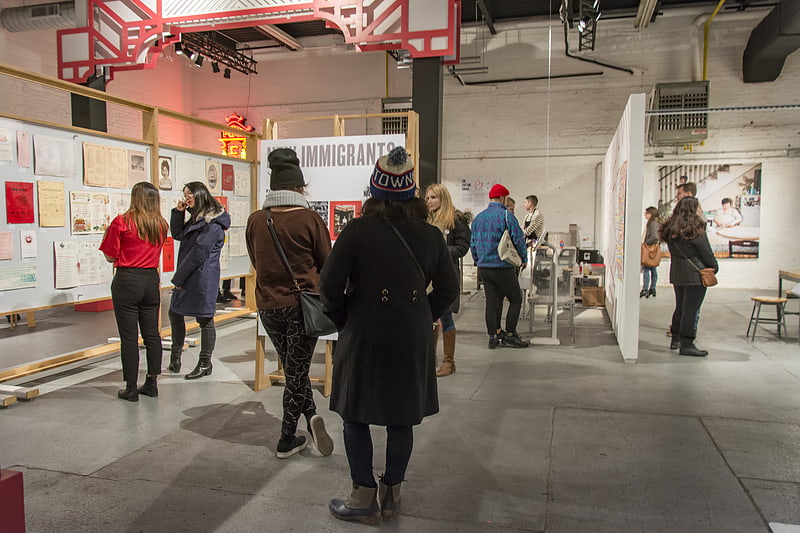
The Museum of Food and Drink is a New York City educational non-profit and museum that seeks to change the way people think about food and drink. The museum's work explores "the ways food and beverage impact our culture, politics, economy, history, and more."[1]
Address: 62 Bayard Street, Sea Gate (Northern Brooklyn)
Squibb Park Bridge
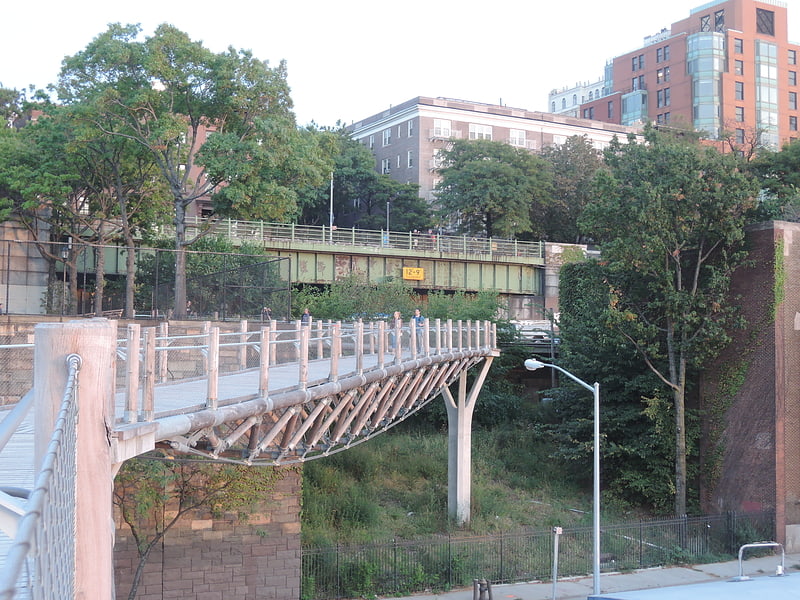
Footbridge in Brooklyn, New York. Squibb Park Bridge is a footbridge connecting Brooklyn Bridge Park and Brooklyn Heights in Brooklyn, New York City. It is the second of two bridges on the same site. The original bridge opened in March 2013 and was demolished in late 2019, being replaced by the current bridge in April 2020.
The original structure, designed by Theodore Zoli, became known as a boondoggle due to various problems with its construction, including too much bounce and deterioration of its timbers. The bridge initially cost $4.1 million to construct, but the cost of repairs ultimately ended up making the total cost $7.5 million. The current bridge, designed by Arup Group and built by Turner Construction, is made of steel.[2]
Church of St. Luke and St. Matthew
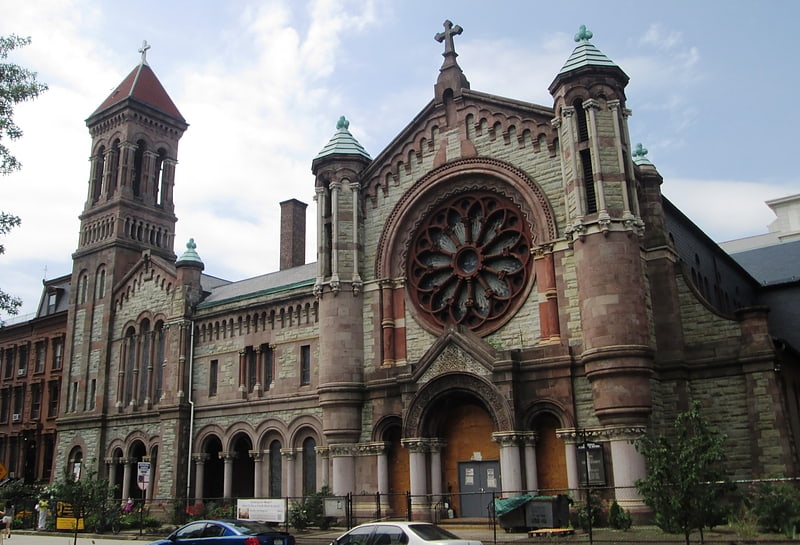
The Church of St. Luke and St. Matthew is a historic Episcopal church at 520 Clinton Avenue between Fulton Street and Atlantic Avenue in the Clinton Hill neighborhood of Brooklyn, New York City. This congregation was founded as St. Luke's Protestant Episcopal Church in 1842 following the failure of Trinity Church, which had been consecrated in the same building on June 1, 1835, by Bishop Onderdonk of the Diocese of Long Island. The founding of a church in this location resulted from the expansion of Brooklyn beyond initial European settlement in Brooklyn Heights. The building was constructed on a property consisting of eight city lots donated by George W. Pine.
The congregation's building eventually grew to be the largest in the Episcopal Diocese of Long Island. It merged with the St. Matthew's Episcopal Church in 1943, and the Church of St. Michael and St. Mark in 1993.[3]
Address: 520 Clinton Avenue, Sea Gate (Northwestern Brooklyn)
Roulette
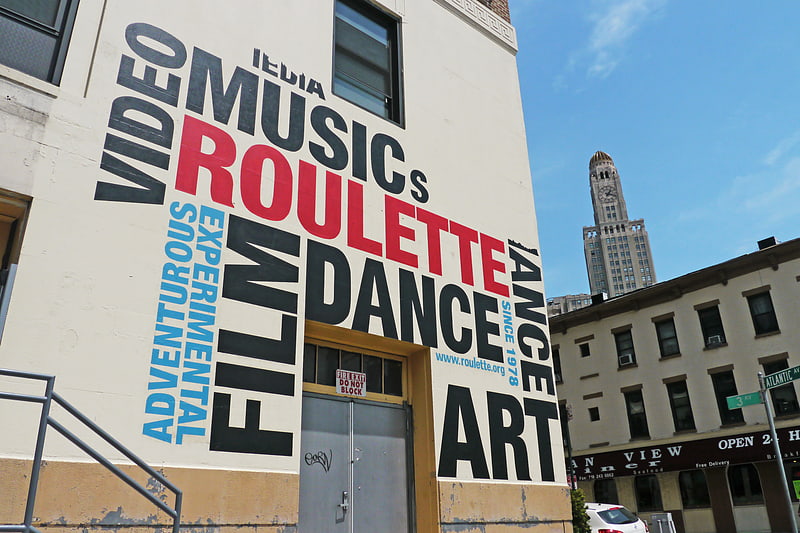
Music venue in Brooklyn, New York. Roulette Intermedium is a performing arts and new music venue located in Brooklyn, New York City. Founded in 1978, it has been located in the neighborhoods of Tribeca and SoHo in Manhattan, and now resides in a renovated theater in downtown Brooklyn. Roulette is a nonprofit organization focusing on fostering experimental dance, new music, and performance.[4]
Address: 509 Atlantic Avenue, Sea Gate (South Brooklyn)
Korean War Veterans Plaza
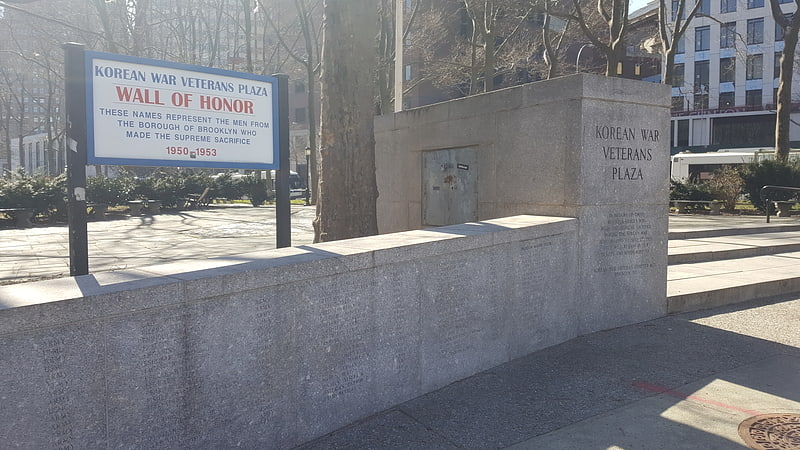
Park in Brooklyn, New York. Korean War Veterans Plaza is a memorial plaza in Brooklyn, New York City, at Fulton and Tillary streets. The plaza features a gate and flagstaff, cast in 1992 and dedicated on November 11 of that year. The park is named in honor of the Brooklyn military personnel who served in the Korean War.[5]
The Invisible Dog Art Center
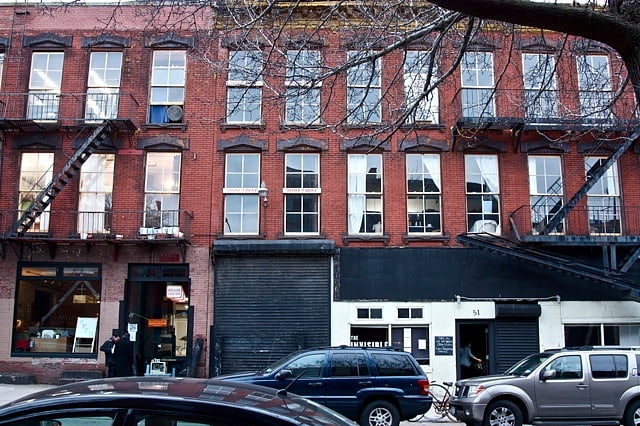
Museum in Brooklyn, New York. The Invisible Dog Art Center is a museum and arts center in Boerum Hill, Brooklyn, New York City, established by Lucien Zayan in 2009. The center gets its name from being a former invisible dog factory. Some buckles, belts, molds, and industrial fixtures remain as remnants throughout the building. The Art Center now plays host to performance and visual art, as well as artists in residence, some of whom have taken on inspiration from the industrial nature of their surroundings.[6]
Bushwick Inlet Park
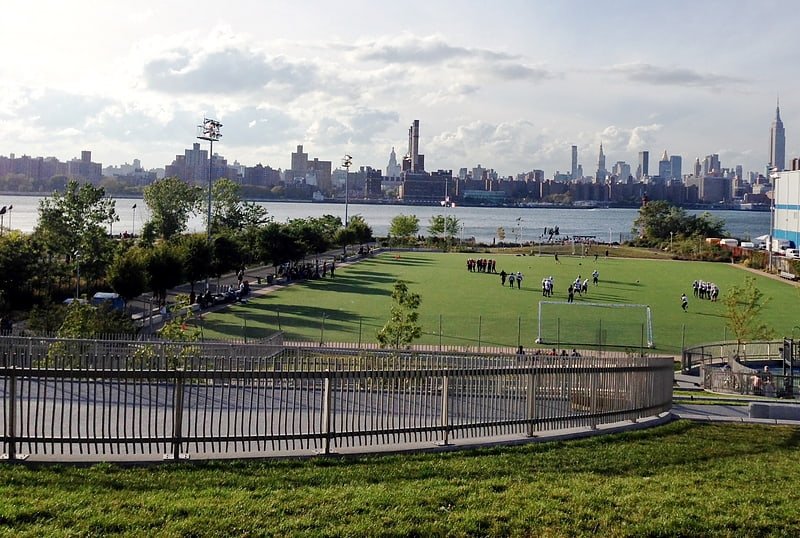
Park in Brooklyn, New York. Bushwick Inlet Park is a public park in the Williamsburg neighborhood of Brooklyn, New York City. The park currently stretches along the East River between North 9th and 12th Streets, and is eventually planned to reach into Greenpoint at Quay Street. The park is named for Bushwick Inlet, which will be in a future northern extension.
Bushwick Inlet was originally a creek named Bushwick Creek, which was fed by two tributaries in Williamsburg. The site of the present-day park was used by manufacturing businesses in the mid-19th century, especially the Brooklyn Eastern District Terminal. By the late 19th century, Bushwick Creek had been used as a sewage outflow from the surrounding area. The creek itself was infilled through various stages, and the infill operations were completed by 1913. Plans for Bushwick Inlet Park were devised in 2005, during the rezoning of a 175-block area in Greenpoint and Williamsburg. However, acquisition of the land took several years and cost tens of millions of dollars. The city was able to complete the purchase of the land for the proposed park in 2016, after years of negotiations.
The only parts of the park that are open to the public are a series of soccer and football fields, which opened in 2010, and a community center, opened in 2013. The community center, which also houses offices for the New York City Department of Parks and Recreation, includes features intended to be environmentally sustainable, such as a sloping green roof, solar panels, and geothermal heating.[7]
Address: 50 Kent Avenue, Sea Gate (Northern Brooklyn)
Golconda Playground
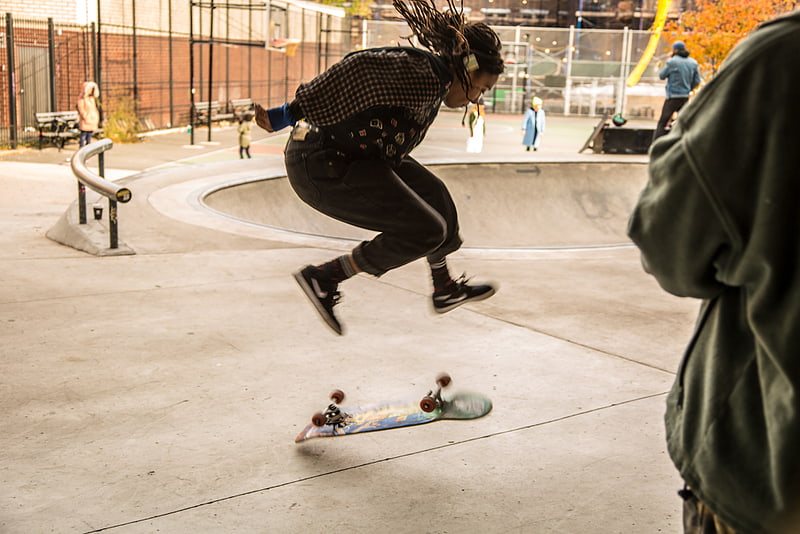
Skateboard park in Brooklyn, New York. Golconda Skate Park, known as Fat Kid, is a public skate park in the Downtown Brooklyn/Fort Greene neighborhoods of Brooklyn, New York City, that originated as a DIY skate spot. Built under the Brooklyn Queens Expressway, the 18,000 square foot professionally built skate park was completed in 2016 and sits within Golconda Playground.[8]
Maria Hernandez Park
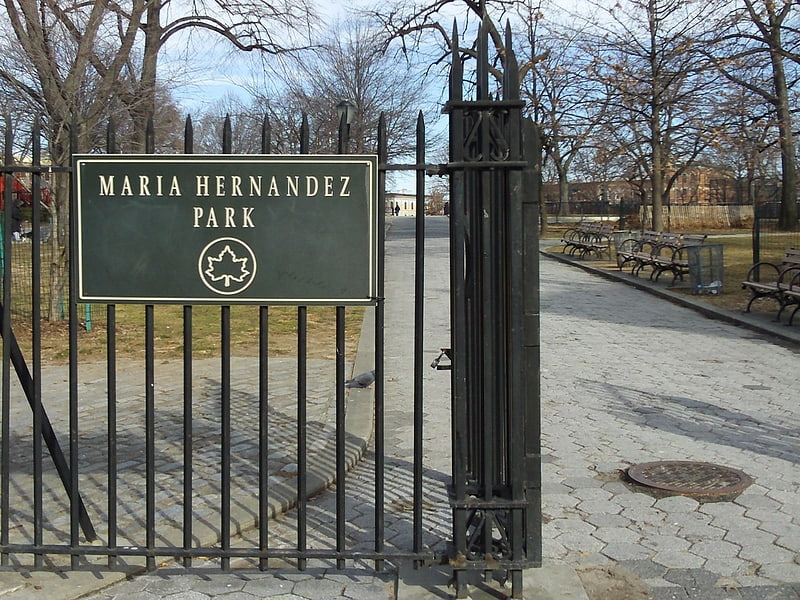
Park in Brooklyn, New York. Maria Hernandez Park is a municipal park in Bushwick, Brooklyn, New York City. It is located between Knickerbocker Avenue on the southwest to Irving Avenue on the northeast, and Starr Street on the northwest to Suydam Street on the southeast. The park is 6.87 acres and is near the Jefferson Street station of the New York City Subway.
The park has four wheelchair-accessible entrances. It has a newly-renovated basketball court, handball court, fitness equipment, spray showers and benches, and a newly built performance stage. The playground was rebuilt with brand new equipment as a result of funds from the mayor and the city council.[9]
Red Hook Park
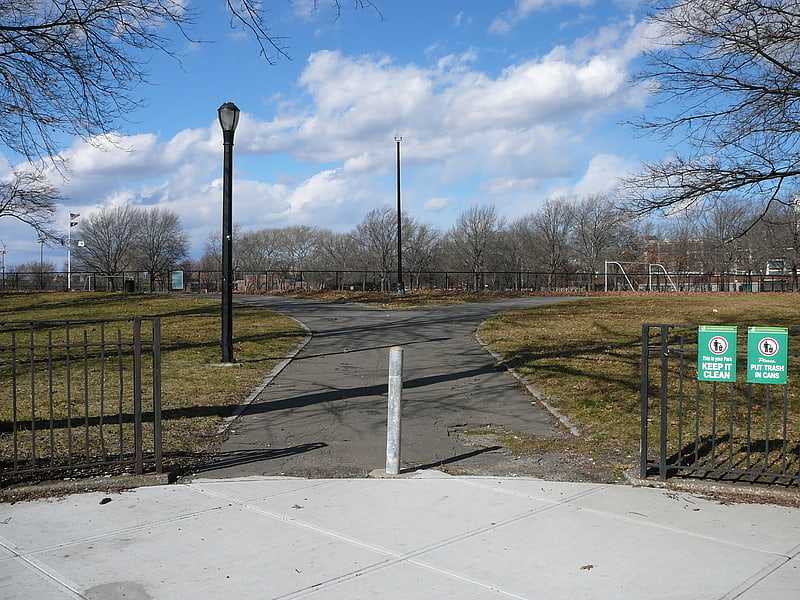
Red Hook Recreation Area, also known as Red Hook Park, is a 58.5-acre public park in the Red Hook neighborhood of Brooklyn, New York City, composed of several segments centered around Bay Street. The park's recreational facilities include handball courts, softball fields, a soccer and football field, and a running track. The Sol Goldman Play Center, within the block bounded by Bay, Henry, Lorraine and Clinton Streets, consists of a brick bathhouse and two pools. The park is operated by the New York City Department of Parks and Recreation, also known as NYC Parks.
The land for the park was acquired starting in 1913 and was transferred to NYC Parks in 1934. Joseph L. Hautman designed the pool, which was constructed from 1935 to 1936 as part of a Works Progress Administration project. The rest of the park opened in 1940. The pool was extensively refurbished from 1983 to 1986; it was renamed for Sol Goldman in 1991 after he donated funds to keep the pool open. The New York City Landmarks Preservation Commission designated the Sol Goldman Play Center as a city landmark in 2007. As a result of extensive lead contamination, the fields were closed and renovated in phases starting in 2019.[10]
Our Lady of Częstochowa-St Casimir Parish

Our Lady of Częstochowa-St Casimir Parish is a church in New York City at 24th Street in Brooklyn. The church, which was designated for Polish immigrants, was founded in 1896. It could also be spelled Częnstochowa, due to the tail on the third letter. The original church building was a wood-frame structure, which was destroyed by a fire in 1904. The replacement was a Gothic Revival Style with a tower and steeple rising to 175 feet that was built on the site of the original church.
This is one of the Polish-American Roman Catholic parishes in New York City in the Diocese of Brooklyn.[11]
Address: 183 25th Street, Sea Gate (South Brooklyn)
Brooklyn War Memorial
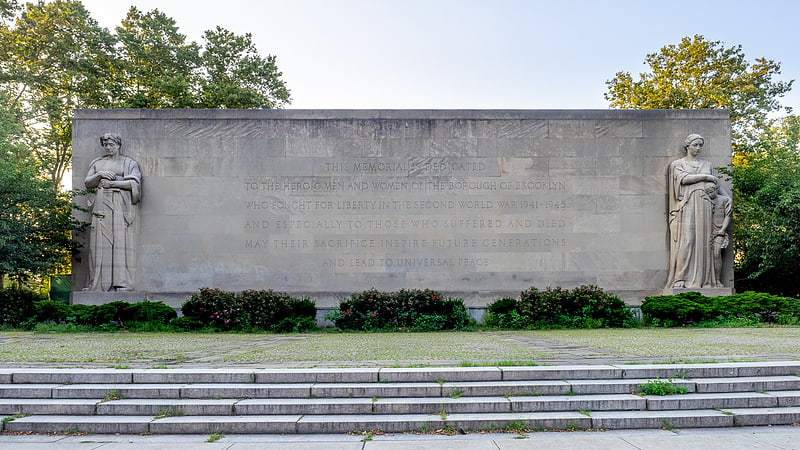
Historical landmark in Brooklyn, New York. The Brooklyn War Memorial is a war memorial installed in Brooklyn's Cadman Plaza, in the U.S. state of New York. It features two high relief figures sculpted by Charles Keck, which represent victory and family, as well as a memorial wall in its main auditorium. The memorial was dedicated in 1951, and later restored in 1977.[12]
Address: 172 Cadman Plaza East, Sea Gate (Northwestern Brooklyn)
Flatbush Malls
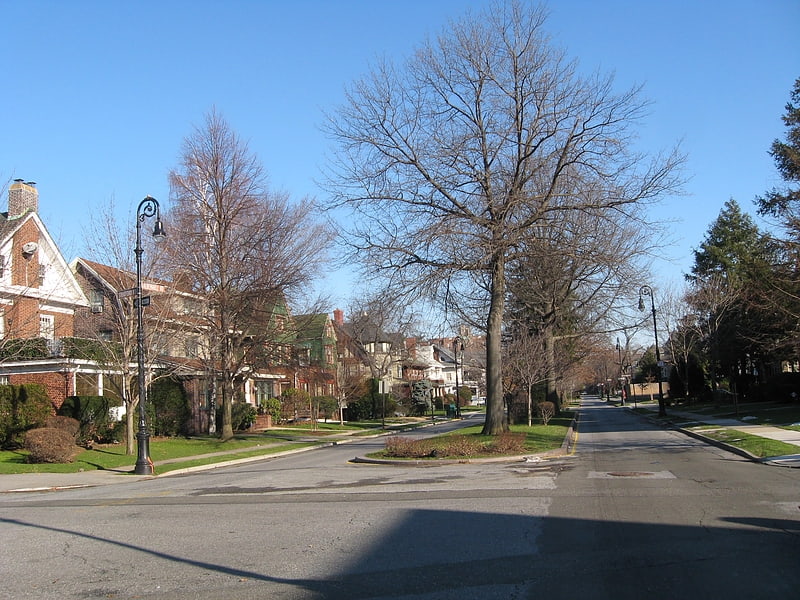
Park in Brooklyn, New York. The Flatbush Malls are a series of tree-lined landscaped medians along several roads in the Victorian Flatbush neighborhood of Brooklyn, New York City. An architecture critic has written that the malls "give the streets an uncommon spaciousness, if not grandeur". The first series was built in the northern part of the neighborhood along Albemarle Road, and extending one block north on Buckingham Road, in the Prospect Park South development of 1899, east of Coney Island Avenue and west of the BMT Brighton Line. This was modeled by the Scottish landscape architect John Aiken on Commonwealth Avenue Mall in Boston, with a design that originally included shrubbery but not trees, and in turn likely inspired the other neighborhood series. The second series, also known as the Midwood Malls, was built in the southern part of the neighborhood along both Glenwood Road, east of Coney Island Avenue and west of Delamere Place, as well as the intersecting East 17th Street, north of the Long Island Railroad cut of the Bay Ridge Branch and south of Foster Avenue, in the Fiske Terrace-Midwood Park developments of 1905.
Part of the malls extending to Flatbush Avenue on Glenwood Road were removed starting in 1932. Both series of malls feature cul-de-sacs on the Brighton Line, with the Glenwood Road series extending to both sides and also having one on the Long Island Railroad cut. All-way stops are installed on the Glenwood Road series, and another was added to the Albemarle Road series due to traffic safety concerns. There has also been concern about the watering of the malls. Both series of malls are owned by the New York City Department of Transportation but maintained by the New York City Department of Parks and Recreation as part of the Greenstreets partnership.[13]
Willink Plaza

The Willink Entrance area, also known as Willink Plaza, is a major urban square of Brooklyn, New York City, formed by the intersection of Flatbush Avenue, Ocean Avenue and Empire Boulevard, at the eastern corner of Prospect Park and the southern corner of the Brooklyn Botanic Garden. It is serviced by the New York City Subway's Prospect Park station, and features several public spaces and historic buildings. This location is considered the northwestern point of the Prospect Lefferts Gardens neighborhood of Flatbush, and adjoins Crown Heights to its northeast.[14]
Mount Prospect Park
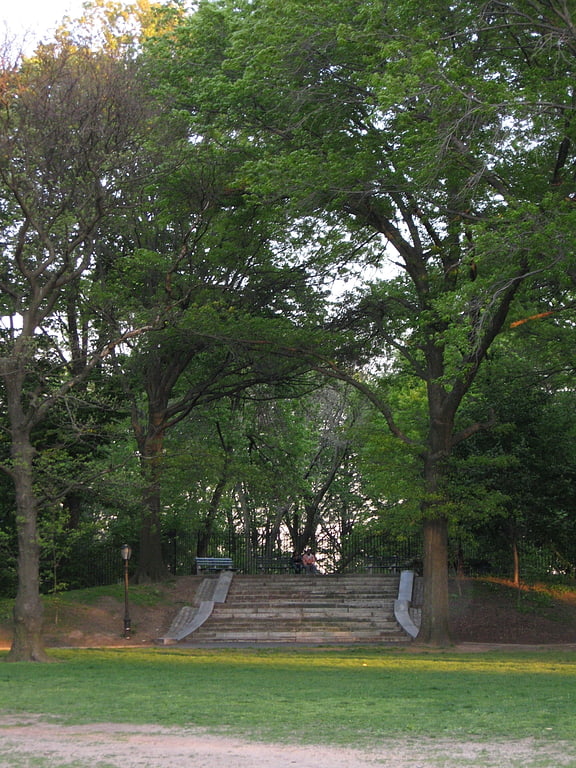
Park in Brooklyn, New York. Mount Prospect Park is a 7.79-acre park in the central portion of the New York City borough of Brooklyn. It includes Mount Prospect, the second highest point in Brooklyn. It is located on Eastern Parkway near Underhill Avenue, close to Grand Army Plaza. The park is operated by the New York City Department of Parks and Recreation.
It is a separate entity from the much larger and better-known Prospect Park, which is across Flatbush Avenue from Mount Prospect Park. Mount Prospect Park is on the same block as three other Brooklyn cultural institutions—the Brooklyn Museum to the east, Brooklyn Botanic Garden to the south, and the Central Library of the Brooklyn Public Library to the west.[15]
Concert Grove

The Concert Grove is a section of Prospect Park, Brooklyn, New York City, that historically functioned as an outdoor music venue. It still serves as a sculpture garden lined with busts of musical figures, largely put up by German American Sängerfest participants and other cultural groups. The Concert Grove also includes the Concert Grove Pavilion, formerly known as the Oriental Pavilion, and adjoins a Lincoln sculpture facing the lake.[16]
Address: 153 East Drive, Sea Gate (South Brooklyn)
Coney Island Creek Park

Park in Brooklyn, New York. Coney Island Creek Park is a public park on the northwestern coast of Coney Island in Brooklyn, New York City. It abuts Coney Island Creek, Gravesend Bay, and Kaiser Park and is across Coney Island Creek from Calvert Vaux Park and Six Diamonds Park.[17]
Lafayette Memorial
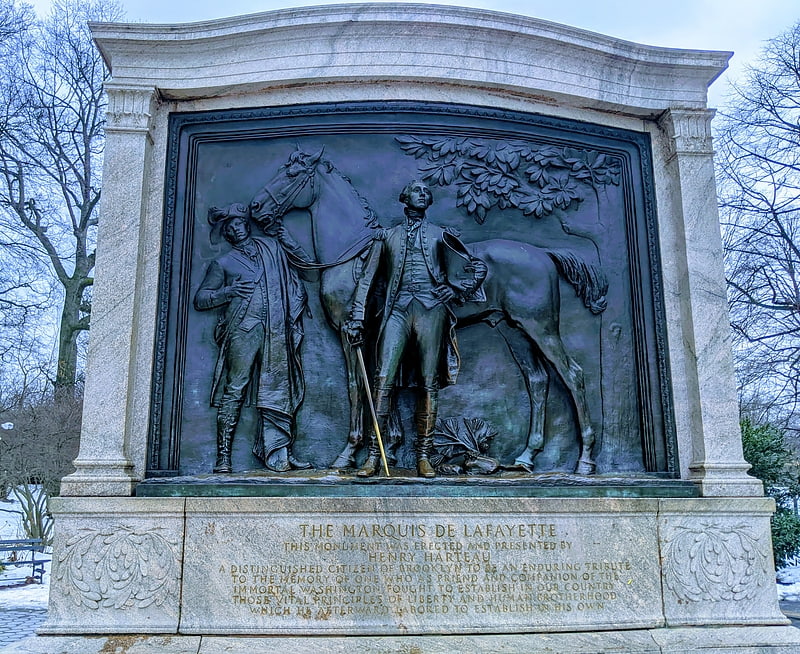
Sculpture by Daniel Chester French and Henry Bacon. The Lafayette Memorial is a public memorial located in Brooklyn's Prospect Park in New York City. The memorial, designed by sculptor Daniel Chester French and architect Henry Bacon, was dedicated in 1917 and consists of a bas-relief of Gilbert du Motier, Marquis de Lafayette alongside a groom and a horse.[18]
Belarusian Autocephalous Orthodox Church
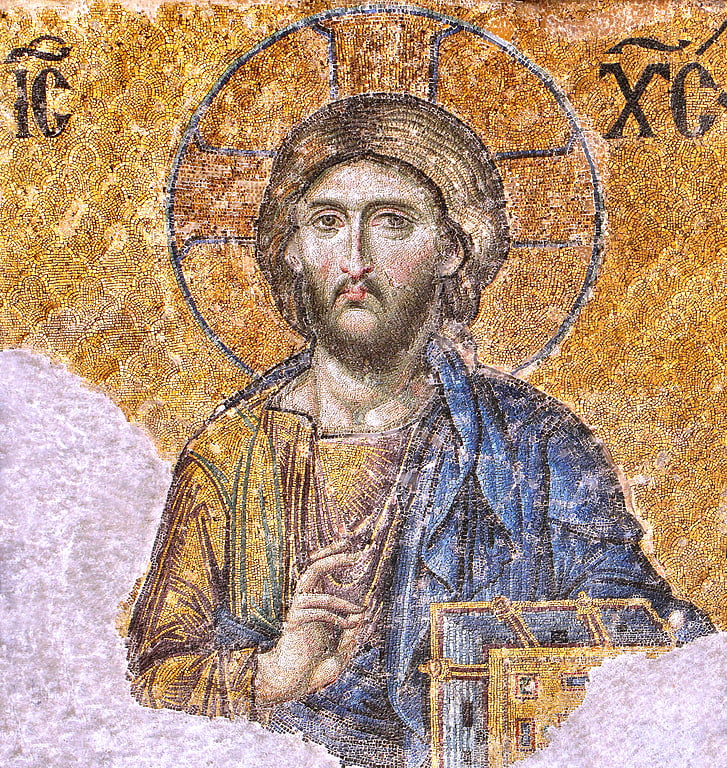
The Belarusian Autocephalous Orthodox Church, sometimes abbreviated as B.A.O. Church or BAOC, is an independent religious body in the Eastern Orthodox tradition.[19]
Address: 401 Atlantic Avenue, Sea Gate (South Brooklyn)
Bailey Fountain

Sculpture by Eugene Savage. Bailey Fountain is an outdoor sculpture in New York City at the site of three 19th century fountains in Grand Army Plaza, Brooklyn, New York, United States. Renovated in 1956 and 2005-06, the 1932 fountain was funded by philanthropist Frank Bailey as a memorial to his wife. After 1974 thefts, some sculpture elements were stored for safekeeping.[20]
Friends Meetinghouse and School
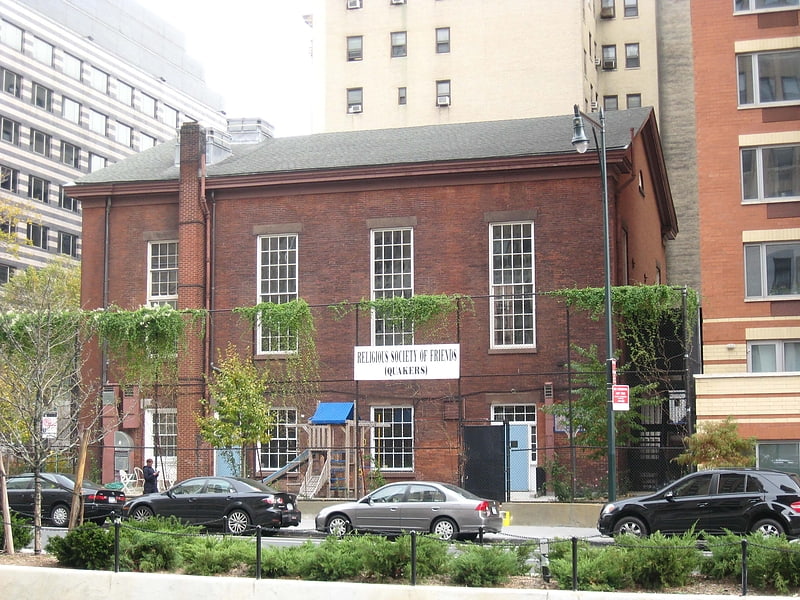
The Friends Meetinghouse and School is an historic Quaker meeting house and adjacent school building at the corner of Schermerhorn Street and Boerum Place in the Boerum Hill neighborhood of Brooklyn, New York City.
The meeting house, at 110 Schermerhorn Street, was built in 1857 and is a 3+1⁄2-story building built of red brick with brownstone details. Its design is attributed to Charles T. Bunting.
The school, located at 112 Schermerhorn Street, was built in 1902 and is a three-story red brick building located adjacent to the meeting house, at 112 Schermerhorn Street. It was designed by William Tubby, a prominent Brooklyn architect, to house the Brooklyn Friends School. Tubby was himself a Quaker and an early graduate of the school.
The meeting house remains in regular use as a house of worship by the Brooklyn Meeting of the Religious Society of Friends. The Brooklyn Friends School moved to another site nearby in 1973. As of 2015, the school building houses Brooklyn Frontiers High School, an alternative school operated by the New York City Department of Education.
The meeting house was designated a New York City landmark in 1981, and the meeting house and school together were listed on the National Register of Historic Places in 1982.[21]
Address: 110 Schermerhorn Street, Sea Gate (South Brooklyn)
Commodore Barry Park
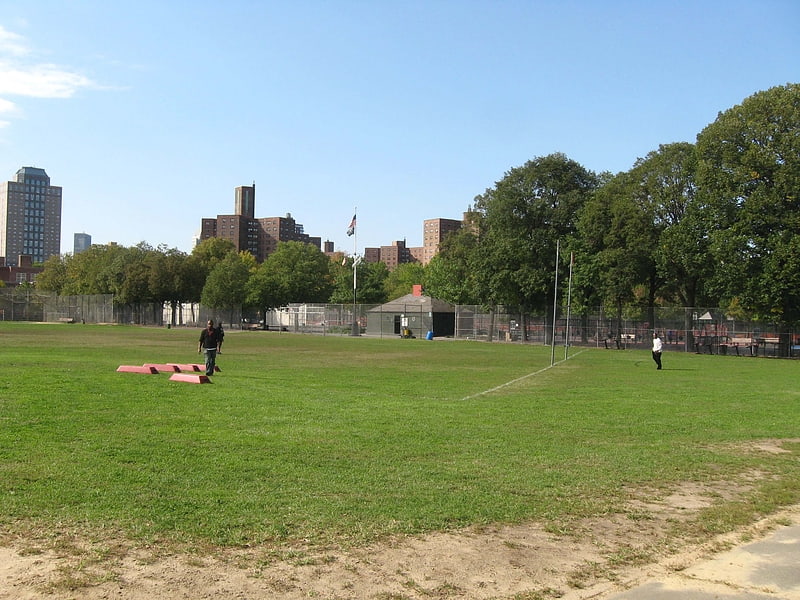
Park in Brooklyn, New York. Commodore Barry Park is an urban park in the Fort Greene neighborhood of the New York City borough of Brooklyn. The park is operated by the New York City Department of Parks and Recreation. It encompasses an area of 10.39 acres and holds baseball, basketball, football, swimming pool and playground fields/facilities. The park was acquired in 1836 by the Village of Brooklyn. When first acquired, it was called "City Park". It is the oldest park in the borough, and it was named for Commodore John Barry in 1951 due to its location next to the Brooklyn Navy Yard that Barry helped found.[22]
Co-Cathedral of St. Joseph
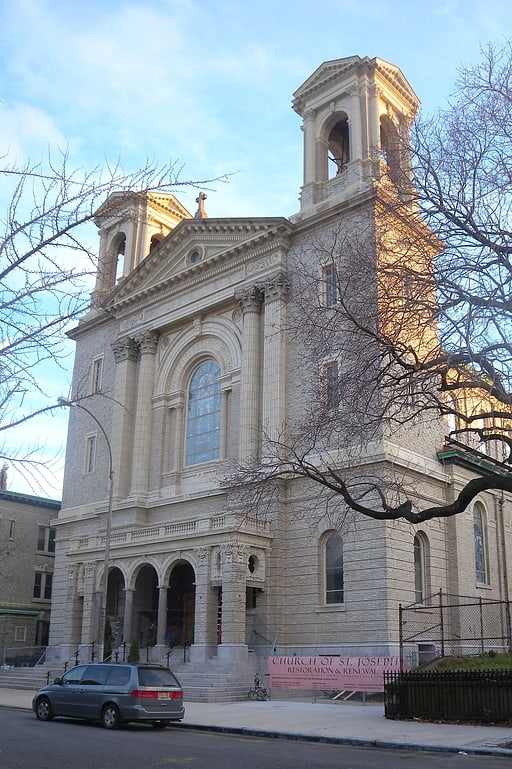
Catholic church in Brooklyn, New York. The Co-Cathedral of St. Joseph of the Roman Catholic Diocese of Brooklyn, located at 856 Pacific Street between Vanderbilt and Underhill Avenues in the Prospect Heights neighborhood of Brooklyn in New York City, was built in 1912 in the Spanish Colonial style, replacing a previous church built in 1861. The parish was founded in 1850 to serve the large immigrant population that was moving into the city of Brooklyn at the time.
On February 14, 2013, Pope Benedict XVI approved the petition of Bishop Nicholas Anthony DiMarzio to have the church designated as the diocesan co-cathedral because the Cathedral Basilica of St. James is too small to hold diocesan liturgies, and because of its prime location near the newly opened Barclays Center and a construction boom that was to include 16,000 new apartments in the area. The church can hold 1,500 worshippers, and as of 2014 averaged 700 at Sunday mass, up from only a few dozen 10 years earlier. The building underwent an $18.5 million renovation.
The church's campus also includes a Gothic revival rectory next door at 834 Pacific Street, built around 1860, and a school at 683 Dean Street, built around 1920, which is now used as a senior center.[23]
Old First Reformed Church
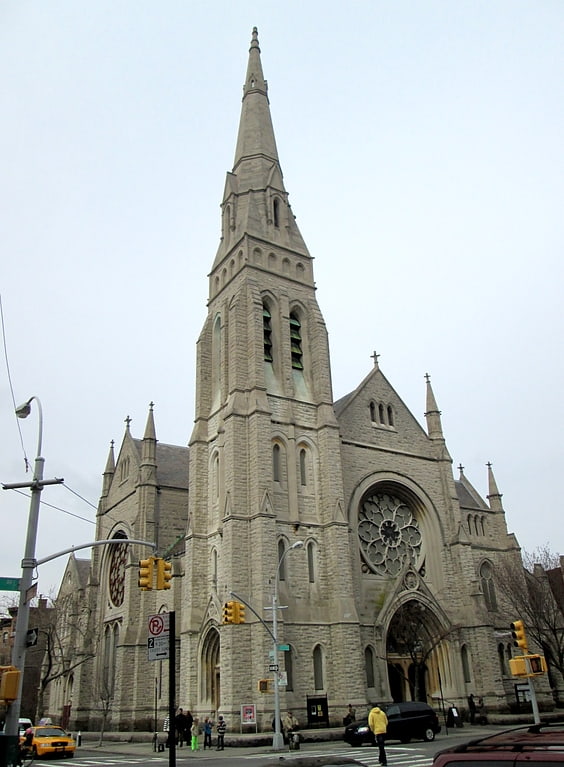
Reformed church in Brooklyn, New York. The Old First Reformed Church in Brooklyn, New York– officially known as The Reformed Dutch Church of the Town of Breukelen – is a historic Dutch Reformed church at 126 7th Avenue on the corner of Carroll Street in the Park Slope neighborhood of Brooklyn, New York, New York. The congregation was founded in 1654 by decree of Governor Pieter Stuyvesant, as one of three "collegiate churches." The current church building was constructed in 1888–1893 and is a Late Gothic Revival style Indiana limestone building on a granite base. It measures 100 feet wide and 162 feet deep. The front facade features a 212-foot-high stone tower and spire.
The church was listed on the National Register of Historic Places in 1998.[24]
Address: 729 Carroll Street, Sea Gate (South Brooklyn)
Greenwood Baptist Church

Baptist church in Brooklyn, New York. Greenwood Baptist Church is an historic Baptist church located in the Park Slope neighborhood of Brooklyn, New York. The congregation was begun as a prayer meeting mission by Reverend Henry Bromley of Strong Place Baptist Church in 1856 and was incorporated as an independent church on September 28, 1858. The current church building was erected in 1900 and is located at 461 6th Street, Brooklyn, NY 11215 at the corner of 7th Avenue. Designed by Adolph Leicht, the Gothic Revival building was listed on the National Register of Historic Places for its architecture in 2016.[25]
Address: 461 6th Street, Sea Gate (South Brooklyn)
Park Slope Jewish Center
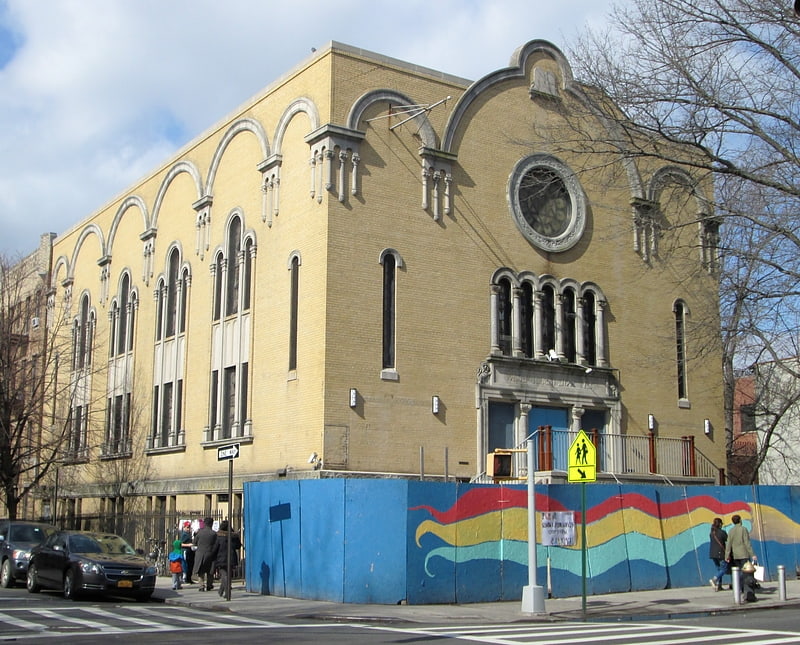
Community center in Brooklyn, New York. The Park Slope Jewish Center, known from 1942 to 1960 as Congregation B'nai Jacob - Tifereth Israel, is an egalitarian Conservative synagogue located at 1320 Eighth Avenue in South Slope, Brooklyn, New York City. It was built in 1925 as the orthodox Congregation B'nai Jacob, and is a 2+1⁄2-story brick building with Romanesque and Baroque style elements. It features the Star of David on exterior masonry, a rose window, and a domed skylight.
The building was listed on the National Register of Historic Places in 2002.
A $1.75 million renovation and expansion was completed in 2015. Rabbi Carie Carter has served the congregation since 2000.[26]
Address: 1320 8th Avenue, Sea Gate (South Brooklyn)
Mark Morris Dance Center

The Mark Morris Dance Center is located in the Fort Greene neighborhood of Brooklyn, New York, at 3 Lafayette Avenue, on the corner of Flatbush Avenue. It is the permanent home of the international touring modern dance company, the Mark Morris Dance Group. Open since 2001, the Center also houses rehearsal space for the dance community, outreach programs for local children and area residents, as well as a school offering dance classes to students of all ages.
In 1996, the Mark Morris Dance Group launched a $7.4 million capital campaign to build what would be its first permanent headquarters in the United States. The Company purchased a derelict building on the corner of Flatbush and Lafayette Avenues in Fort Greene, Brooklyn, and broke ground in 1999. The architectural firm, Beyer Blinder Belle Architects and Planners, designed the building, which today consists of 5 stories, seven column-free studios with wood-sprung floors, spacious locker rooms with showers, a wellness center, a 140-seat performance space, and offices for the Company's administrative staff. Seven studios are available to rent at discounted rates to non-profit dance companies, and range in size from 430 square feet to 3,600 square feet.[27]
Address: 3 Lafayette Street, Sea Gate (Northwestern Brooklyn)
Sts. Constantine and Helen Greek Orthodox Cathedral
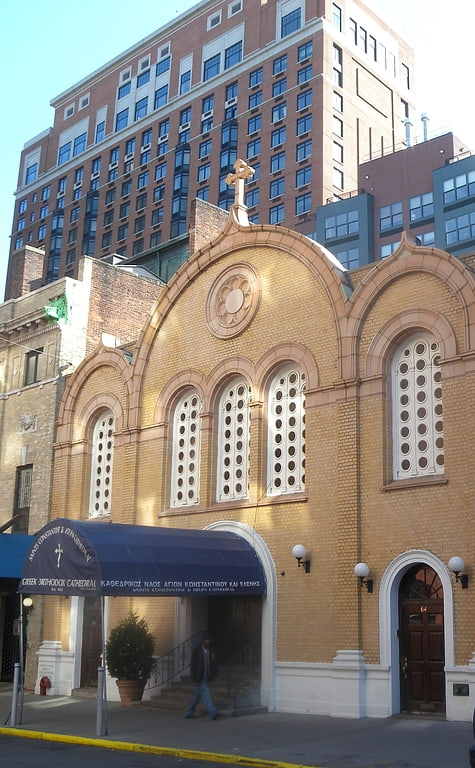
The Greek Orthodox Cathedral of Sts. Constantine and Helen, more simply Sts. Constantine and Helen Cathedral is a Greek Orthodox cathedral church at 64 Schermerhorn Street in Downtown Brooklyn, New York. It is best known for taking in parishioners from St. Nicholas Greek Orthodox Church in Manhattan, destroyed during the September 11 attacks.
Founded in 1913, it was the first Greek Orthodox parish on Long Island, and is one of the oldest Greek Orthodox churches in the City of New York. After meeting for several years in a small building at Johnson and Lawrence streets, the community raised funds to build a new structure, whose cornerstone was laid April 16, 1916.
Fire damaged the building in 1991, but repairs have been made and the building restored. The Church also is affiliated with A. Fantis Parochial School, which was established in 1963, 50 years after the church, and which is located right behind the church. The Church is half a block west of the New York Transit Museum.
The church was expanded in 1946 and again in 1960. It was designated Brooklyn's cathedral in June 1966.[28]
Address: 64 Schermerhorn Street, Sea Gate (South Brooklyn)
Brooklyn Tabernacle

Megachurch in Brooklyn, New York. Brooklyn Tabernacle is an evangelical non-denominational megachurch located at 17 Smith Street at the Fulton Mall in downtown Brooklyn, New York City. The senior pastor is Jim Cymbala.[29]
Address: 17 Smith Street, Sea Gate (Northwestern Brooklyn)
Wunsch Building
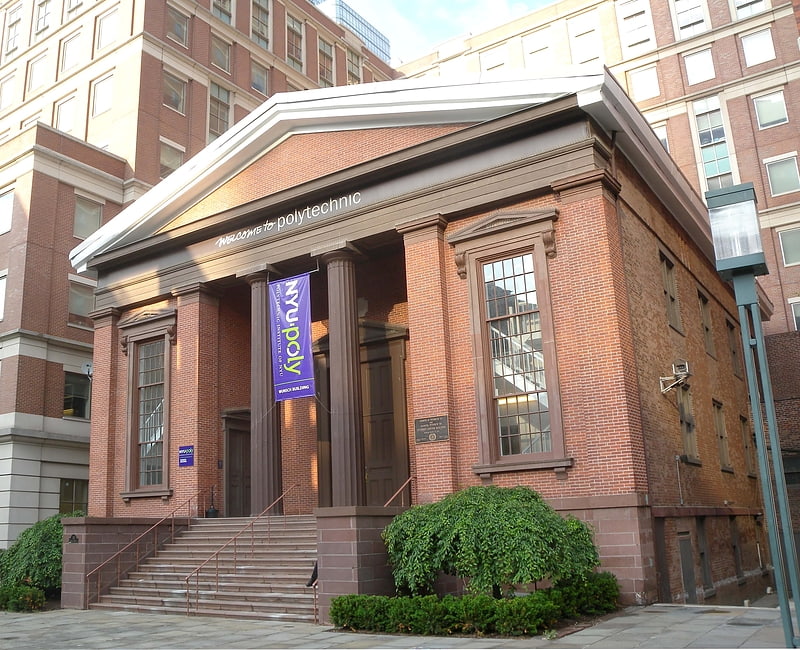
University in Brooklyn, New York. The Wunsch Building of New York University Tandon School of Engineering is the present name of the former Bridge Street Methodist Church, a former Methodist church located at 311 Bridge Street, on the east side between Johnson Street and Myrtle Avenue, in Downtown Brooklyn, New York City. The Greek Revival temple was erected 1844. It is also recorded as the First Congregational Church.
The building dates to 1847 and was the first independent black church in Brooklyn. It was also a stop on the Underground Railroad and has been designated a historic landmark since November 24, 1981.
The former church was recorded in the AIA Guide to New York City (1977) as the NYU Tandon School of Engineering annex. "A Greek Revival temple in brick with wood columns and entablature: chaste, excepting the later Victorian stained glass, which is exuberant even from the outside."
The church building is now called the Wunsch Building and houses the school's Undergraduate Admissions offices. It is used to host many social, cultural, and academic events for the school and community.[30]
Walt Whitman Park
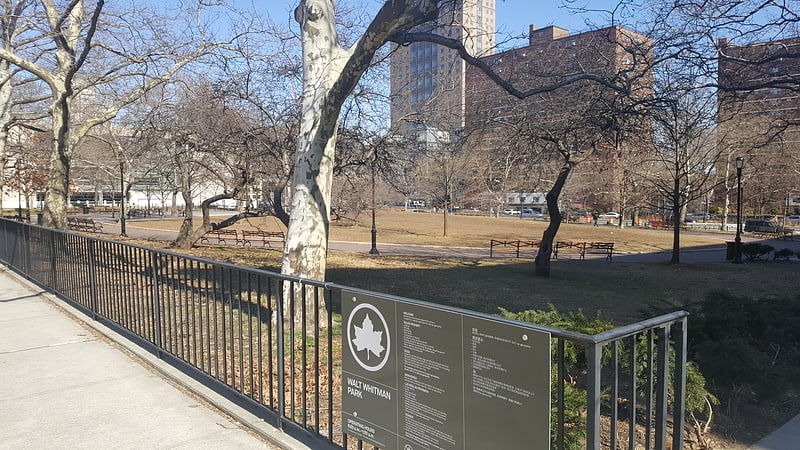
Park in Brooklyn, New York. Walt Whitman Park is a park in the Downtown Brooklyn section of Brooklyn, New York City, commemorating Walt Whitman. It is adjacent to Cadman Plaza East to the west and Adams Street to the east.[31]
WNYC Transmitter Park

Park in Brooklyn, New York. WNYC Transmitter Park is a 6.61-acre public park located in the Greenpoint neighborhood of Brooklyn, New York City, where Greenpoint Avenue dead-ends by the East River shoreline. The site was acquired by the public radio station WNYC in 1935 as the site of twin antennas used for broadcasting. From 1937 to 1990, the city-operated station broadcast its AM signal from this location. Following the adoption of antennas in Kearny, New Jersey and atop the World Trade Center, the Greenpoint property sat unused. Construction on WNYC Transmitter Park began in August 2010 and the park opened two years later in September 2012.
WNYC Transmitter Park still contains WNYC's old transmitter house.
The park also includes a playground. And dominating the park from what would otherwise be a bleak brick wall is an enormous mural of a girl with flowers, by the artist Faile.[32]
First Unitarian Congregational Society
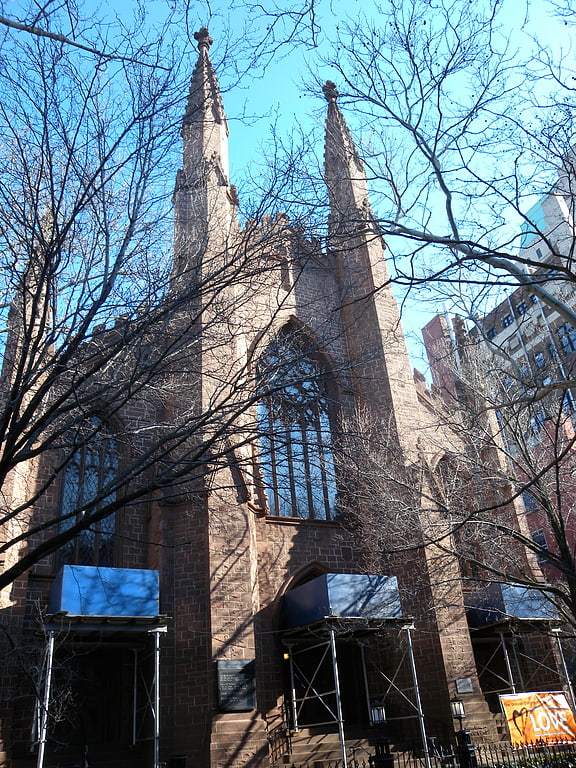
First Unitarian Congregational Society in Brooklyn is a Unitarian Universalist congregation in Brooklyn, NY. The Society was established in 1833 and has been worshiping in its historic Gothic Revival Sanctuary since 1844. The Sanctuary is adorned with stained glass windows and a Louis C. Tiffany angel mosaic. It is one of the earliest Unitarian congregations in the United States, established just 8 years after the American Unitarian Association was formed in 1825.[33]
Address: 50 Monroe Place, Sea Gate (Northwestern Brooklyn)
John J Carty Park
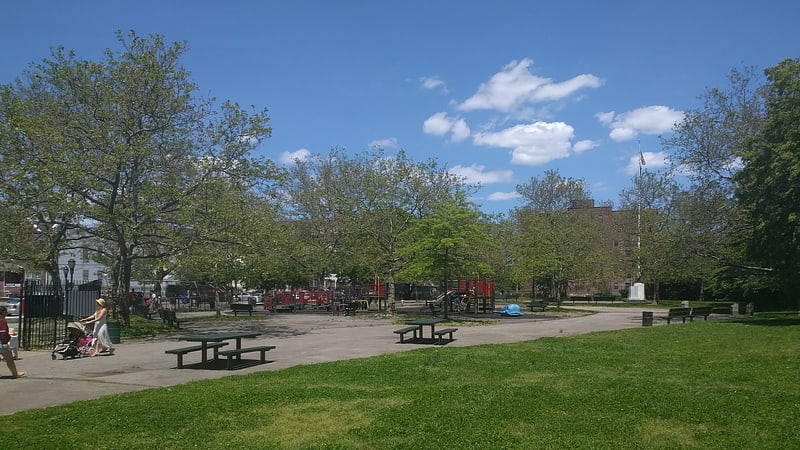
Park in Brooklyn, New York. John J. Carty Park, also known as Rubber Park, is located in Bay Ridge, Brooklyn. This park honors John J. Carty, a native of Bay Ridge, Brooklyn who lived his life only five blocks away and dedicated himself to New York City government for 32 years.[34]
Theatre for a New Audience
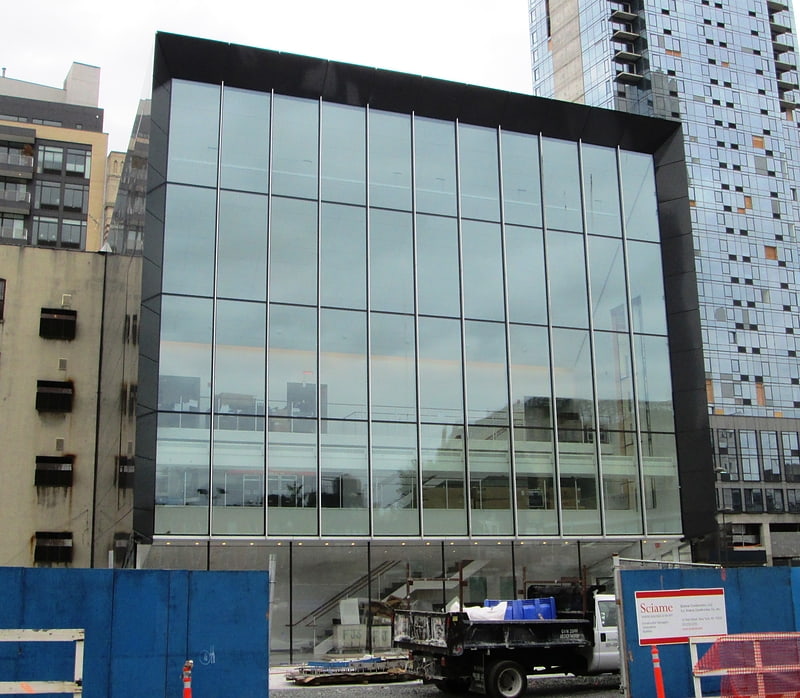
The Theatre for a New Audience is a non-profit theater in New York City focused on producing Shakespeare and other classic dramas. Its off-Broadway productions have toured in the U.S. and internationally.[35]
Address: 95 Rockwell Place, Sea Gate (Northwestern Brooklyn)